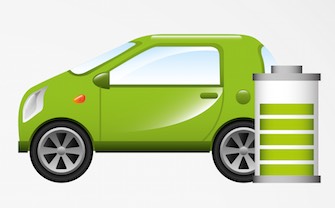 Today we return to our on-going auto series here on IPWatchdog where we compare sectors of innovation among the world’s largest automakers as we continue to try tracking how American auto development stacks up against the rest of the world. Earlier this year, we noted reports being published by Thomson Reuters which showed us that the rate of innovation in the American auto sector was in decline compared to the rest of the world. With the auto manufacturing industry in a chaotic place in terms of how we typically think about domestic and foreign car production, we wanted to see how American-based carmakers were faring in sectors of research and development which are fairly active right now, like in autonomous automobiles.
Today we return to our on-going auto series here on IPWatchdog where we compare sectors of innovation among the world’s largest automakers as we continue to try tracking how American auto development stacks up against the rest of the world. Earlier this year, we noted reports being published by Thomson Reuters which showed us that the rate of innovation in the American auto sector was in decline compared to the rest of the world. With the auto manufacturing industry in a chaotic place in terms of how we typically think about domestic and foreign car production, we wanted to see how American-based carmakers were faring in sectors of research and development which are fairly active right now, like in autonomous automobiles.
Electric vehicles (EVs) are another area where we’ve been noting a lot of activity in both research & development. It’s clear that electric vehicles won’t be completely squeezing fuel cell technology out of the market but many auto manufacturers are focused on developing lithium-ion battery technologies for cars. We’ve even noted innovation in the field of wireless induction charging for vehicles, eliminating the need to plug into an outlet at all. Interestingly, the EV sector of the patent world has shown unusual activity over the past year or so. Citing a lack of interest from other carmakers, as well as an anti-patent stance that is looking more hypocritical every day, Tesla Motors Inc. (NASDAQ:TSLA) CEO Elon Musk announced last June that his company would no longer enforce its patent rights to prevent infringing products from entering the market. This summer, Ford Motor Company (NYSE:F) provided licensing guidance for technologies reflected in hundreds of patents and patent applications; licensees still need to pay for the right to practice the technology but it could be symptomatic of a change in the conventional “not invented here” bias permeating the auto industry.
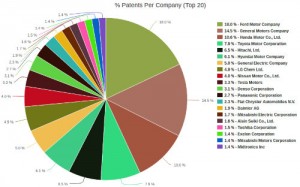 When looking specifically at patents that specifically mention “electric vehicles,” it looks as though there are reasons to feel good about America’s place in the world; some purists may note that many of these patents are for hybrid electric vehicles, but we’ll be taking an inclusive point of view today. Both Ford and General Motors Company (NYSE:GM) are atop the leaderboard in this sector, placing first and second overall respectively. Ford itself holds almost one-fifth of all electric vehicle IP and together the two American companies give our country just about one-third of the patents in this field at 32.5 percent, as we can see from the pie chart we have thanks to the patent analysis portfolio tools at Innography. In third place is Honda Motor Co. (NYSE:HMC), followed by Toyota Motor Corp. (NYSE:TM) of Japan, a company that also has a pretty dominant position in fuel cell vehicle technologies as well. Together, they give Japan a solid position as runner-up to the EV innovation happening in America.
When looking specifically at patents that specifically mention “electric vehicles,” it looks as though there are reasons to feel good about America’s place in the world; some purists may note that many of these patents are for hybrid electric vehicles, but we’ll be taking an inclusive point of view today. Both Ford and General Motors Company (NYSE:GM) are atop the leaderboard in this sector, placing first and second overall respectively. Ford itself holds almost one-fifth of all electric vehicle IP and together the two American companies give our country just about one-third of the patents in this field at 32.5 percent, as we can see from the pie chart we have thanks to the patent analysis portfolio tools at Innography. In third place is Honda Motor Co. (NYSE:HMC), followed by Toyota Motor Corp. (NYSE:TM) of Japan, a company that also has a pretty dominant position in fuel cell vehicle technologies as well. Together, they give Japan a solid position as runner-up to the EV innovation happening in America.
American Automaker EV Patents: From Ford’s Charger Seeking Tech to GM’s Range Extender
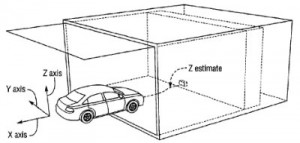 Ford’s portfolio of 459 U.S. patents in EVs showcase a focus on the development of plug-in hybrid electric vehicles (PHEV), the automobile that draws power from an electrical utility grid for battery storage that we typically picture when we think about electric vehicles. U.S. Patent No. 9033075, which is titled Auto-Seek Electrical Connection for a Plug-In Hybrid Electric Vehicle, claims a method for controlling a battery-powered vehicle by controlling an electric traction motor to incrementally advance position of the vehicle towards a stationary charging element, controlling power steering to steer the vehicle towards the element and controlling the suspension to align a charging connector with the charging element. This innovation is intended to make sure that a vehicle is charged if an owner forgets to plug it in overnight. We’re also very intrigued to not the self-driving aspects of this technology as autonomous vehicle development is a sector that we’ve been covering closely all year long. More economical energy management systems in PHEVs are the subject of U.S. Patent No. 9050969, issued under the title Trip Oriented Energy Management Control. This patent discloses a PHEV with a controller configured to operate an engine and an electric machine so that the state of charge of a battery achieves a charge-depletion-to-charge-sustaining transition threshold after the vehicle has been driven a distance longer than the total distance that the vehicle could be driven exclusively by the electric machine. This energy management control system for a PHEV better incorporates trip distance information enables more system optimization in a hybrid vehicle, improving fuel economy.
Ford’s portfolio of 459 U.S. patents in EVs showcase a focus on the development of plug-in hybrid electric vehicles (PHEV), the automobile that draws power from an electrical utility grid for battery storage that we typically picture when we think about electric vehicles. U.S. Patent No. 9033075, which is titled Auto-Seek Electrical Connection for a Plug-In Hybrid Electric Vehicle, claims a method for controlling a battery-powered vehicle by controlling an electric traction motor to incrementally advance position of the vehicle towards a stationary charging element, controlling power steering to steer the vehicle towards the element and controlling the suspension to align a charging connector with the charging element. This innovation is intended to make sure that a vehicle is charged if an owner forgets to plug it in overnight. We’re also very intrigued to not the self-driving aspects of this technology as autonomous vehicle development is a sector that we’ve been covering closely all year long. More economical energy management systems in PHEVs are the subject of U.S. Patent No. 9050969, issued under the title Trip Oriented Energy Management Control. This patent discloses a PHEV with a controller configured to operate an engine and an electric machine so that the state of charge of a battery achieves a charge-depletion-to-charge-sustaining transition threshold after the vehicle has been driven a distance longer than the total distance that the vehicle could be driven exclusively by the electric machine. This energy management control system for a PHEV better incorporates trip distance information enables more system optimization in a hybrid vehicle, improving fuel economy.
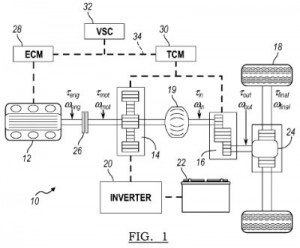 A system designed to ensure that a hybrid electric vehicle maintains its position while resting on an incline is featured within U.S. Patent No. 9108621, which is titled Controlling Powertrain Components for Hill-Holding in a Hybrid Electric Vehicle. The vehicle protected here for Ford includes an engine, a traction motor, a first coupling device for selectively coupling the engine to the traction motor, an inverter electrically connected to the traction motor, a second coupling device that selectively couples the traction motor to the wheels and a controller configured to partially disengage the second coupling device and activate the engine based on the temperature of the traction motor and the inverter. We were also interested to find a unique solar panel technology created by Ford for charging electric vehicles, detailed within U.S. Patent No. 9090163, titled Vehicle Solar Panel Array with High Voltage Output. The automotive vehicle claimed here has a battery pack that includes a plurality of electrically connected storage cells each having an output voltage at a target storage cell state of charge; the battery pack is also configured to provide energy to move the vehicle. The invention also involves a plurality of solar cells electrically connected in a series to form a solar panel array and a controller that selectively electrically connect the panel array and the battery pack to charge the battery. The innovation seeks to reduce the direct costs that a car owner must pay to charge an electric vehicle.
A system designed to ensure that a hybrid electric vehicle maintains its position while resting on an incline is featured within U.S. Patent No. 9108621, which is titled Controlling Powertrain Components for Hill-Holding in a Hybrid Electric Vehicle. The vehicle protected here for Ford includes an engine, a traction motor, a first coupling device for selectively coupling the engine to the traction motor, an inverter electrically connected to the traction motor, a second coupling device that selectively couples the traction motor to the wheels and a controller configured to partially disengage the second coupling device and activate the engine based on the temperature of the traction motor and the inverter. We were also interested to find a unique solar panel technology created by Ford for charging electric vehicles, detailed within U.S. Patent No. 9090163, titled Vehicle Solar Panel Array with High Voltage Output. The automotive vehicle claimed here has a battery pack that includes a plurality of electrically connected storage cells each having an output voltage at a target storage cell state of charge; the battery pack is also configured to provide energy to move the vehicle. The invention also involves a plurality of solar cells electrically connected in a series to form a solar panel array and a controller that selectively electrically connect the panel array and the battery pack to charge the battery. The innovation seeks to reduce the direct costs that a car owner must pay to charge an electric vehicle.
Some people bemoan the short ranges that EVs can drive on a full charge when compared to gas-powered vehicles but GM, which holds a portfolio of 370 U.S. patents related to EVs, is hoping to change that at least somewhat through U.S. Patent No. 9002552, titled Compact Electric Range Extender for an Electric Vehicle. The electric vehicle protected here includes a rechargeable energy storage system (RESS) electrically connected to a traction motor and an auxiliary power unit which has a set of induction windings, an outer ring, an inner ring which is coaxial with and positioned radially within the outer ring wherein the rings are rotatable to generate electricity on the set of induction windings, an engine disposed radially within an inner ring and a controller that detects when the energy level of a RESS drops below a threshold and for selectively energizing the APU. Systems for facilitating billing at electric 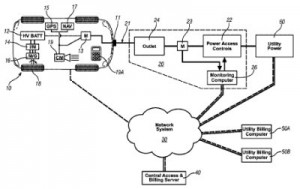 charging stations are discussed within U.S. Patent No. 9037507, titled Method to Facilitate Opportunity Charging of an Electric Vehicle. The method for charging a high-voltage battery of a vehicle protected here involves a monitoring, on a vehicle owner’s handheld device, the geographical location of the vehicle and transmitting that information to a control module, resolving the location of the vehicle at a specific power outlet of a charging station and transmitting that location to a central server and, at the central server, providing billing and access to the remote charging site. This system also includes a mechanism allowing a charging site owner to create credit and debit accounts for individual vehicle owners.
charging stations are discussed within U.S. Patent No. 9037507, titled Method to Facilitate Opportunity Charging of an Electric Vehicle. The method for charging a high-voltage battery of a vehicle protected here involves a monitoring, on a vehicle owner’s handheld device, the geographical location of the vehicle and transmitting that information to a control module, resolving the location of the vehicle at a specific power outlet of a charging station and transmitting that location to a central server and, at the central server, providing billing and access to the remote charging site. This system also includes a mechanism allowing a charging site owner to create credit and debit accounts for individual vehicle owners.
GM has also incorporated an interesting safety system into its electric vehicle products, as we can see within U.S. Patent No. 8988212, which is titled Electric Vehicle Pedestrian Warning System. The pedestrian warning system disclosed here includes an encapsulating container which is disposed outside of the vehicle’s interior cabin, a speaker affixed within the encapsulating container, an amplifier coupled to the speaker, a computer processor communicatively coupled to the amplifier and the vehicle network and logic that can be executed to transmit a sound file to the speaker upon activation of the electric vehicle. This system, which produces sound that mimics internal combustion engines so that pedestrians can better hear an approaching vehicle, is designed to cost less money to produce and create less unwanted noise within the vehicle cabin.
Japan Automaker EV Patents: From Honda’s Electric Motorcycles to Toyota’s Theft Prevention Device
Honda’s portfolio of 272 U.S. patents in electric vehicles trails GM by about 100 patents but it does find the company third overall in the EV development field and some showcase a real commitment to environmental friendliness. One technology developed to allow electric vehicle owners to make sure that electricity drawn from a vehicle comes from renewable sources is outlined within U.S. Patent No. 9024571, entitled Charging of Electric Vehicles Based on Historical Clean Energy Profiles. The computer-implemented method for charging an electric vehicle claimed here involves receiving information about an electric vehicle’s geographic location when the vehicle is connected to an electrical grid, providing options for charging the vehicle which include an option to maximize renewable energy sources, identifying a clean energy profile of a geographic region surrounding the vehicle’s location and delaying charging of a vehicle to maximize its draw on renewable energy resources. It would seem that this innovation would actually make charging take longer but the patent’s summary indicates that the main reason for this technology is to satisfy those customers who want to reduce their carbon footprint.
 Not every electric vehicle innovation is all about cars. Honda, which also makes motorcycles, has created an improved configuration for a battery pack on an electric motorcycle which is described within U.S. Patent No. 9027692, which is titled Electric Saddled Vehicle and Drive Device for Electric Vehicle. This patent protects an electric saddled vehicle with a vehicle body frame, a drive wheel, a drum brake braking the drive wheel, a swing unit which is swingably supported by a vehicle body frame and including a drive motor separate from the drive wheel, and then a speed-reducing mechanism that transmits a power from the drive motor to the drive wheel. The configuration of these components are such that the left-right balance of the resulting electric motorcycle is
Not every electric vehicle innovation is all about cars. Honda, which also makes motorcycles, has created an improved configuration for a battery pack on an electric motorcycle which is described within U.S. Patent No. 9027692, which is titled Electric Saddled Vehicle and Drive Device for Electric Vehicle. This patent protects an electric saddled vehicle with a vehicle body frame, a drive wheel, a drum brake braking the drive wheel, a swing unit which is swingably supported by a vehicle body frame and including a drive motor separate from the drive wheel, and then a speed-reducing mechanism that transmits a power from the drive motor to the drive wheel. The configuration of these components are such that the left-right balance of the resulting electric motorcycle is 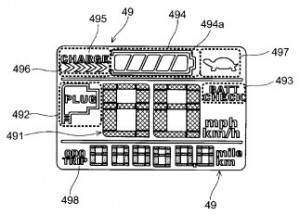 improved. Honda has also developed an electric meter display optimized for the smaller form of motorcycles, protected by U.S. Patent No. 9108519, which is titled Meter Display Device for Electric Vehicles. The electric vehicle claimed here includes a main battery, a motor generating drive power for the vehicle by electricity supplied from the battery, a control section controlling the motor’s output, a charging connector including terminals supplying electrical power from an external to the main battery and a meter display device with a display section displaying information on vehicle speed and a charging connector condition. This display can indicate information regarding the maintenance of charging connector equipment to the owner of an electric vehicle.
improved. Honda has also developed an electric meter display optimized for the smaller form of motorcycles, protected by U.S. Patent No. 9108519, which is titled Meter Display Device for Electric Vehicles. The electric vehicle claimed here includes a main battery, a motor generating drive power for the vehicle by electricity supplied from the battery, a control section controlling the motor’s output, a charging connector including terminals supplying electrical power from an external to the main battery and a meter display device with a display section displaying information on vehicle speed and a charging connector condition. This display can indicate information regarding the maintenance of charging connector equipment to the owner of an electric vehicle.
The large IP holdings over at Toyota include 201 U.S. patent grants related to EV technologies. Techniques that leverage certain aspects of the charging scheme for EVs to prevent the stealing of vehicles is the focus of U.S. Patent No. 8957760, which is titled Electric Vehicle Theft Preventing Device. The vehicle theft preventing device disclosed here includes a charging device that sends a prohibition request signal that prohibits the function of a vehicle while charging, a vehicle side-control unit configured to disallow authorization in response to the prohibition request signal and an authentication device that transmits the prohibition request signal to the vehicle side-control unit upon receiving an ID signal which identifies the vehicle. This technology provides a more effective scheme for discouraging theft when a stolen or duplicate key is involved by disabling vehicle operation when its plugged into the grid. More effective systems for collecting kinetic energy created by certain vehicle operations is at the center of U.S. Patent No. 9020674, which is titled Diversion of Energy from Regenerative Braking. The patent protects a regenerative braking system that includes a generator coupled with a vehicle for generating energy during deceleration of a vehicle, a battery switchably coupled with the generator for receiving a portion of the energy, two devices switchably coupled with the generator also for receiving energy and a processor that controls switchable coupling of the generator with the battery and two devices based on the battery’s state of charge and the air temperature of the vehicle’s interior. This innovation is designed to reduce energy waste when the battery’s state of charge is full, preventing it from receiving any additional energy, by allowing that energy to be used by other systems within the vehicle.
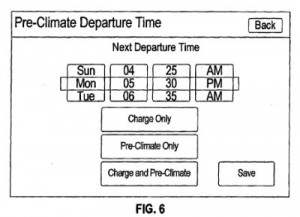 Finally, we felt like sharing a Toyota innovation that allows EV owners to schedule charging times more effectively reflected within U.S. Patent No. 9045042, titled System and Method for a One-Time Departure Schedule Setup for Charging Battery-Electric Vehicles. The computer-based method for allowing a one-time change to a primary departure schedule of a vehicle protected here involves receiving the primary departure schedule for activating a battery management and charging unit (BMCU) for charging the vehicle or a heating, ventilation and air condition (HVAC) unit to perform pre-climate operations, receiving an immediate charge mode designation or a primary departure charge mode designation, setting a vehicle’s charge mode to an immediate charge mode when that is the most recent charge mode designation, deactivating the BMCU’s charging operation or the HVAC’s pre-climate operation to temporarily prevent the charging operation during the immediate charge period, charging the battery through the BMCU unit after the charge mode is changed and returning the current charge mode to a primary departure charge mode after the charging operation has ended. This system is designed to allow EV owners who utilize on-board vehicle tools for scheduling charging an improved and easier ability to create a one-time edit in the primary charging schedule.
Finally, we felt like sharing a Toyota innovation that allows EV owners to schedule charging times more effectively reflected within U.S. Patent No. 9045042, titled System and Method for a One-Time Departure Schedule Setup for Charging Battery-Electric Vehicles. The computer-based method for allowing a one-time change to a primary departure schedule of a vehicle protected here involves receiving the primary departure schedule for activating a battery management and charging unit (BMCU) for charging the vehicle or a heating, ventilation and air condition (HVAC) unit to perform pre-climate operations, receiving an immediate charge mode designation or a primary departure charge mode designation, setting a vehicle’s charge mode to an immediate charge mode when that is the most recent charge mode designation, deactivating the BMCU’s charging operation or the HVAC’s pre-climate operation to temporarily prevent the charging operation during the immediate charge period, charging the battery through the BMCU unit after the charge mode is changed and returning the current charge mode to a primary departure charge mode after the charging operation has ended. This system is designed to allow EV owners who utilize on-board vehicle tools for scheduling charging an improved and easier ability to create a one-time edit in the primary charging schedule.

![[IPWatchdog Logo]](https://ipwatchdog.com/wp-content/themes/IPWatchdog%20-%202023/assets/images/temp/logo-small@2x.png)

![[[Advertisement]]](https://ipwatchdog.com/wp-content/uploads/2023/01/2021-Patent-Practice-on-Demand-1.png)
![[[Advertisement]]](https://ipwatchdog.com/wp-content/uploads/2024/04/Patent-Litigation-Masters-2024-banner-early-bird-ends-Apr-21-last-chance-938x313-1.jpeg)
![[Advertisement]](https://ipwatchdog.com/wp-content/uploads/2024/04/Patent-Litigation-Masters-2024-sidebar-early-bird-ends-Apr-21-last-chance-700x500-1.jpg)

![[Advertisement]](https://ipwatchdog.com/wp-content/uploads/2021/12/WEBINAR-336-x-280-px.png)
![[Advertisement]](https://ipwatchdog.com/wp-content/uploads/2021/12/2021-Patent-Practice-on-Demand-recorded-Feb-2021-336-x-280.jpg)
![[Advertisement]](https://ipwatchdog.com/wp-content/uploads/2021/12/Ad-4-The-Invent-Patent-System™.png)







Join the Discussion
2 comments so far.
Gene Quinn
September 14, 2015 12:33 pmJim-
Get a grip. I know you Tesla fan boys think the entire world revolves around Elon Musk, but not every single article can be about Tesla. Grow up!
We write about Tesla a lot, including how much of a hypocrite Elon Musk is with respect to patents. Inform yourself! Start here:
https://ipwatchdog.com/2015/08/11/elon-musk-patent-hypocrisy-on-display-in-growing-solarcity-patent-portfolio/id=60153/
https://ipwatchdog.com/2015/09/10/musks-tesla-does-poor-job-of-avoiding-patents/id=61439/
https://ipwatchdog.com/2015/06/07/government-subsidies-helped-elon-musk/id=58427/
-Gene
Jim Stack
September 14, 2015 11:33 amWhat about Tesla and US Patents?? They have to be the World leader. Maybe there should be a study on results not just paper pusher patents.
Oh maybe it’s because Telsa opened their tech and released patents so others could try and follow?